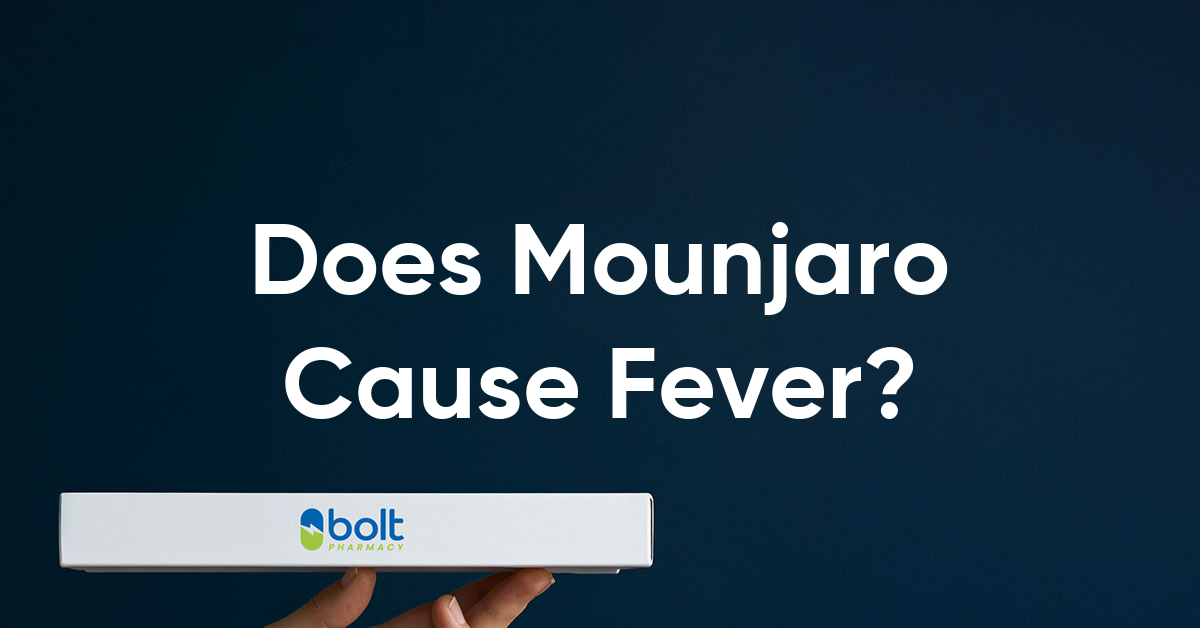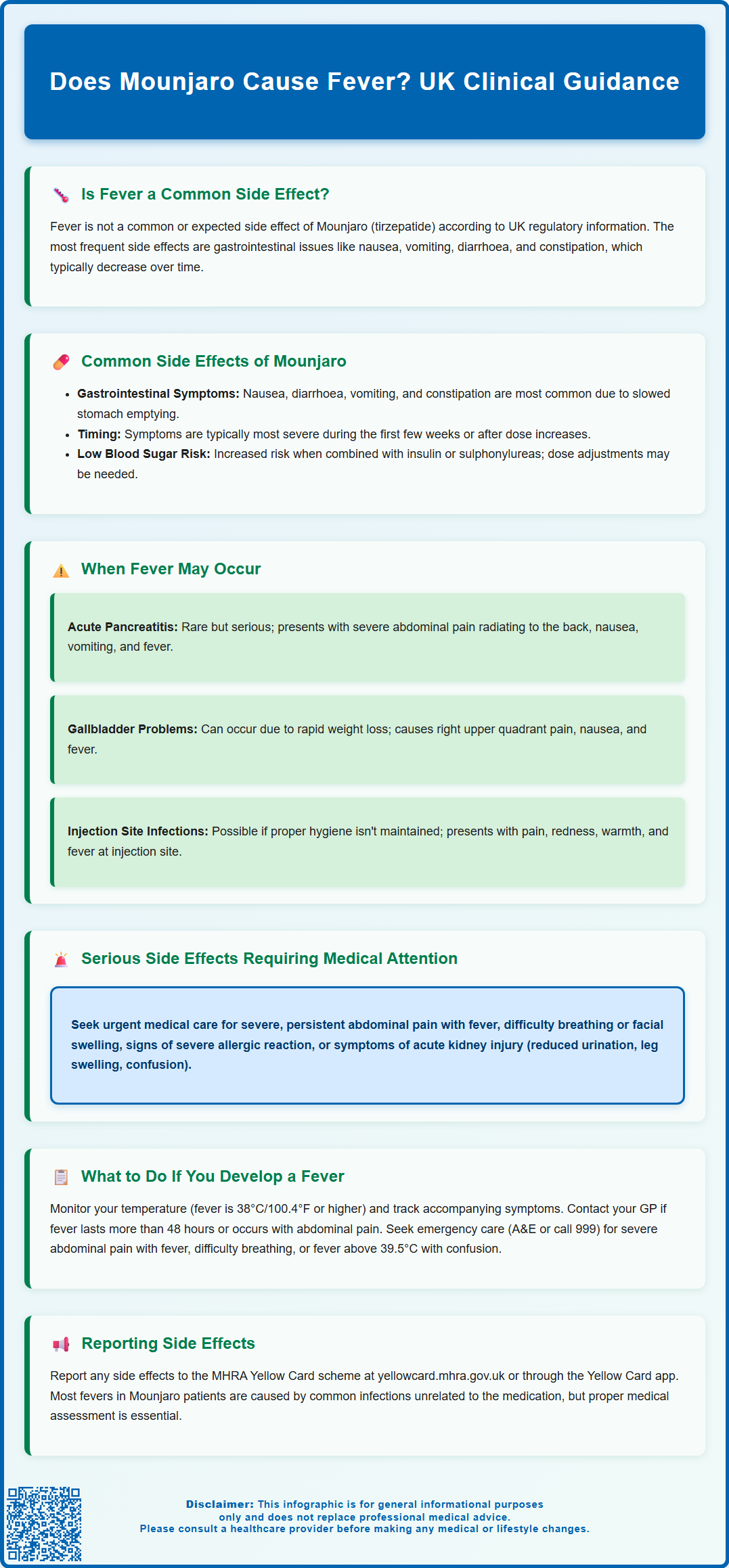Wegovy®
A weekly GLP-1 treatment proven to reduce hunger and support meaningful, long-term fat loss.
- ~16.9% average body weight loss
- Boosts metabolic & cardiovascular health
- Proven, long-established safety profile
- Weekly injection, easy to use

Mounjaro (tirzepatide) is a dual GLP-1 and GIP receptor agonist licensed in the UK for type 2 diabetes mellitus. Patients and clinicians often ask: does Mounjaro cause fever? Fever is not listed as a common side effect in the MHRA-approved Summary of Product Characteristics. However, fever may occasionally occur secondary to rare complications such as pancreatitis or gallbladder disease, or from unrelated concurrent illness. Understanding when fever warrants medical attention is essential for safe Mounjaro use. This article examines the relationship between Mounjaro and fever, common side effects, and when to seek medical advice.
Summary: Fever is not a common or expected side effect of Mounjaro (tirzepatide), but may rarely occur secondary to complications such as pancreatitis or gallbladder disease.
Mounjaro (tirzepatide) is a glucagon-like peptide-1 (GLP-1) and glucose-dependent insulinotropic polypeptide (GIP) receptor agonist licensed in the UK for the treatment of type 2 diabetes mellitus. Tirzepatide is also available under the brand name Zepbound for weight management in adults with obesity or overweight with weight-related comorbidities. Whilst Mounjaro is generally well tolerated, patients and healthcare professionals often enquire about its potential to cause fever.
Fever is not listed as a common or expected side effect of Mounjaro in the Summary of Product Characteristics (SmPC) approved by the Medicines and Healthcare products Regulatory Agency (MHRA). The most frequently reported adverse reactions relate to the gastrointestinal system, including nausea, vomiting, diarrhoea, and constipation. These effects are typically mild to moderate in severity and tend to diminish over time as the body adjusts to the medication.
However, it is important to recognise that fever can occasionally occur in the context of certain complications or reactions associated with Mounjaro use. For instance, fever may develop secondary to pancreatitis or gallbladder disease—conditions that, whilst rare, have been reported in patients taking GLP-1 receptor agonists and are listed in the warnings section of the SmPC. Additionally, fever may arise from unrelated concurrent illness, making it essential to consider the broader clinical picture rather than attributing fever solely to the medication.
Patients experiencing fever whilst taking Mounjaro should not dismiss it as a routine side effect. A thorough assessment is necessary to identify the underlying cause and determine whether the fever is related to the medication, a complication of treatment, or an independent medical condition requiring prompt attention.
If you experience side effects, report them to the MHRA Yellow Card scheme at yellowcard.mhra.gov.uk or via the Yellow Card app.
Understanding the typical adverse effect profile of Mounjaro helps patients and clinicians distinguish between expected reactions and those that warrant further investigation. The most common side effects of tirzepatide are gastrointestinal in nature, reflecting the drug's mechanism of action, which includes delayed gastric emptying and effects on appetite regulation.
Gastrointestinal side effects reported in clinical trials include:
Nausea – very common, particularly during dose escalation
Diarrhoea – very common, can range from mild to moderate and may be transient
Vomiting – very common, often occurs in conjunction with nausea, especially in the initial weeks of treatment
Constipation – common, affects a smaller proportion of patients but can be troublesome
Abdominal pain or discomfort – common, typically mild and self-limiting
Decreased appetite – very common, an intended therapeutic effect but may be experienced as an adverse reaction by some patients
These gastrointestinal symptoms are generally most pronounced during the first few weeks of treatment or following dose increases. The MHRA-approved dosing schedule for Mounjaro involves gradual titration, starting at 2.5 mg once weekly for 4 weeks, then increasing to 5 mg, with further 2.5 mg increments at 4-week intervals up to a maximum of 15 mg once weekly as tolerated. This approach helps reduce the likelihood and severity of gastrointestinal effects.
Other common side effects include injection site reactions (such as redness, itching, or swelling) and hypoglycaemia—particularly when Mounjaro is used in combination with insulin or sulfonylureas. Patients taking Mounjaro alongside these medications may require dose adjustments of their insulin or sulfonylurea under medical supervision to reduce hypoglycaemia risk.
Patients should be counselled about these expected reactions and reassured that most gastrointestinal symptoms improve with continued use. However, persistent or severe symptoms should prompt medical review to exclude complications such as pancreatitis or gallbladder disease, which, although uncommon, require prompt recognition and management.

Whilst fever is not a direct pharmacological effect of tirzepatide, there are specific clinical scenarios in which patients taking Mounjaro may develop a fever. Recognising these situations is crucial for appropriate clinical assessment and management.
Acute pancreatitis is a rare but serious adverse reaction associated with GLP-1 receptor agonists, including Mounjaro, as noted in the MHRA SmPC warnings (section 4.4). Patients with acute pancreatitis typically present with severe, persistent abdominal pain (often radiating to the back), nausea, vomiting, and fever. The MHRA advises that Mounjaro should be discontinued if pancreatitis is suspected, and patients should be monitored closely. Risk factors include a history of pancreatitis, gallstones, hypertriglyceridaemia, and alcohol excess.
Cholecystitis and cholelithiasis (gallbladder inflammation and gallstones) have been reported in patients taking GLP-1 receptor agonists, likely related to rapid weight loss and altered gallbladder motility, as mentioned in the SmPC warnings. Acute cholecystitis can present with right upper quadrant pain, nausea, vomiting, and fever. Patients experiencing these symptoms require urgent assessment, including blood tests (inflammatory markers, liver function tests) and imaging (ultrasound scan).
Injection site reactions are common with Mounjaro. While the SmPC does not specifically list injection site infections as a common adverse reaction, any injection site could potentially become infected if proper technique and hygiene are not maintained. If signs of infection develop (increasing pain, redness, warmth, swelling at the injection site, and systemic symptoms such as fever), medical review is necessary. Patients should be educated on correct subcutaneous injection technique and the importance of rotating injection sites.
Finally, it is essential to remember that fever may be entirely unrelated to Mounjaro and instead reflect a concurrent infection (such as influenza, COVID-19, urinary tract infection, or respiratory tract infection) or other medical condition. A comprehensive clinical assessment, including history, examination, and appropriate investigations, is necessary to determine the cause of fever in any patient taking Mounjaro.
Whilst Mounjaro is generally safe and effective when used appropriately, certain serious adverse reactions require immediate medical attention. Patients and healthcare professionals should be vigilant for warning signs that may indicate a potentially life-threatening complication.
Acute pancreatitis, as previously mentioned, is a medical emergency. Patients should seek urgent medical care if they experience severe, persistent abdominal pain (particularly if radiating to the back), accompanied by nausea, vomiting, and fever. Diagnosis is confirmed through elevated serum lipase or amylase levels (typically more than three times the upper limit of normal) and imaging findings. As stated in the MHRA SmPC, Mounjaro must be discontinued permanently if pancreatitis is confirmed.
Severe hypersensitivity reactions, including anaphylaxis, have been reported rarely with GLP-1 receptor agonists. Symptoms may include difficulty breathing, swelling of the face, lips, tongue or throat, severe rash or itching, dizziness, and rapid heartbeat. Patients experiencing these symptoms should stop Mounjaro immediately and seek emergency medical assistance.
Severe hypoglycaemia can occur when Mounjaro is used in combination with insulin or sulfonylureas. This is a medical emergency requiring immediate treatment. Patients should be educated about hypoglycaemia symptoms and management, and concomitant medication doses may need adjustment by their healthcare provider.
Acute kidney injury has been reported, particularly in patients who develop severe gastrointestinal side effects leading to dehydration. Warning signs include reduced urine output, swelling of the legs or ankles, confusion, and fatigue. Patients with pre-existing renal impairment or those taking other nephrotoxic medications require careful monitoring.
Diabetic retinopathy complications may occur, particularly when rapid improvements in glycaemic control take place. The SmPC notes that rapid improvement in glucose control has been associated with temporary worsening of diabetic retinopathy. Patients with a history of diabetic retinopathy should have regular eye examinations and report any sudden changes in vision to their healthcare provider.
Severe or persistent gastrointestinal symptoms—including intractable nausea, vomiting, or diarrhoea—warrant medical review, as they may lead to dehydration, electrolyte disturbances, and acute kidney injury. NICE guidance (NG28) for type 2 diabetes management emphasises the importance of patient education regarding recognition of serious adverse effects and appropriate help-seeking behaviour.
If you develop a fever whilst taking Mounjaro, it is important to take appropriate steps to identify the cause and seek medical advice when necessary. Fever is defined as a body temperature of 38°C (100.4°F) or higher and may indicate an underlying infection or complication requiring treatment.
Initial steps to take:
Monitor your temperature regularly using a reliable thermometer and keep a record of readings
Assess accompanying symptoms – note any abdominal pain, nausea, vomiting, injection site changes, urinary symptoms, respiratory symptoms, or other concerns
Stay well hydrated – drink plenty of fluids, particularly if you have gastrointestinal symptoms
Do not stop taking Mounjaro without consulting your healthcare provider, unless you have severe abdominal pain (possible pancreatitis) or signs of a severe allergic reaction, in which case stop immediately and seek urgent medical care
When to contact your GP or healthcare provider:
Fever persisting for more than 48 hours
Fever accompanied by abdominal pain
Signs of injection site infection (increasing redness, warmth, swelling, or discharge)
Persistent vomiting or diarrhoea leading to dehydration
Any other concerning symptoms
When to seek urgent medical attention (A&E, NHS 111, or call 999):
Severe, persistent abdominal pain with fever (possible pancreatitis)
Signs of severe allergic reaction (difficulty breathing, facial swelling, severe rash)
High fever (above 39.5°C) with confusion or drowsiness
Signs of severe dehydration (reduced urine output, dizziness, rapid heartbeat)
Your healthcare provider will conduct a thorough assessment, which may include physical examination, blood tests (including inflammatory markers, lipase, renal function), and imaging studies if indicated. Treatment will depend on the underlying cause identified. Remember that most fevers in patients taking Mounjaro are due to common infections unrelated to the medication, but a proper medical assessment is essential to ensure appropriate care and exclude serious complications.
If you suspect your fever may be related to Mounjaro, report this as a possible side effect to the MHRA Yellow Card scheme at yellowcard.mhra.gov.uk or via the Yellow Card app.
No, fever is not listed as a common side effect in the MHRA-approved Summary of Product Characteristics for Mounjaro. The most common side effects are gastrointestinal, including nausea, vomiting, and diarrhoea.
Seek urgent medical attention if you develop fever with severe abdominal pain (possible pancreatitis), signs of injection site infection, persistent vomiting or diarrhoea, or high fever above 39.5°C with confusion. Contact your GP if fever persists beyond 48 hours or is accompanied by other concerning symptoms.
Acute pancreatitis is a rare but serious complication of Mounjaro that can present with severe abdominal pain, nausea, vomiting, and fever. If pancreatitis is suspected, Mounjaro must be discontinued immediately and urgent medical assessment is required.
The health-related content published on this site is based on credible scientific sources and is periodically reviewed to ensure accuracy and relevance. Although we aim to reflect the most current medical knowledge, the material is meant for general education and awareness only.
The information on this site is not a substitute for professional medical advice. For any health concerns, please speak with a qualified medical professional. By using this information, you acknowledge responsibility for any decisions made and understand we are not liable for any consequences that may result.
Lorem ipsum dolor sit amet, consectetur adipiscing elit, sed do eiusmod tempor incididunt ut labore et dolore magna aliqua. Ut enim ad minim veniam, quis nostrud exercitation ullamco laboris nisi ut aliquip ex ea commodo consequat. Duis aute irure dolor in reprehenderit in voluptate velit esse cillum dolore eu fugiat nulla pariatur.
Block quote
Ordered list
Unordered list
Bold text
Emphasis
Superscript
Subscript